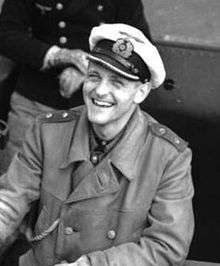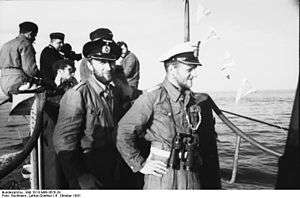Erich Topp
| Erich Topp | |
|---|---|
 | |
| Born |
2 July 1914 Hannover |
| Died |
26 December 2005 (aged 91) Süßen |
| Allegiance |
|
| Service/ |
|
| Years of service |
1934–45 1958–69 |
| Rank |
Kriegsmarine: Fregattenkapitän Bundesmarine: Konteradmiral |
| Service number | NSDAP #2,621,078 |
| Commands held |
U-57 U-552 U-3010 U-2513 |
| Awards |
Knight's Cross of the Iron Cross with Oak Leaves and Swords Great Cross of Merit |
Erich Topp (2 July 1914 – 26 December 2005) was the third most successful of German U-Boat commanders of World War II. He was a recipient of the Knight's Cross of the Iron Cross with Oak Leaves and Swords of Nazi Germany. He sank 35 ships for a total of 197,460 gross register tons (GRT). After the war he served with the Federal German Navy, reaching the rank of Konteradmiral (rear admiral). He later served in NATO.
Early life and career
Topp was born in Hannover, the son of an engineer, and joined the Reichsmarine in 1934, serving on the light cruiser Karlsruhe in 1937, before transferring to the U-Bootwaffe (submarine fleet) in October 1937. In May 1933, Topp joined the Nazi Party and in 1934 also joined the Allgemeine-SS.[1]
World War II
He served as Watch Officer on U-46 under the command of Herbert Sohler and took part in four combat patrols before he was given his first command on U-57 on 5 June 1940. He led U-57 on two missions during which the boat managed to sink six ships. She was sunk after a collision with a Norwegian vessel on 3 September 1940.

Topp survived to take command of U-552, a Type VIIC boat — on 4 December 1940. With U-552, Der Rote Teufel, he operated mainly against convoys in the North Atlantic, sinking 30 ships and crippling several others on ten patrols. One of his victories during this period was sinking of the destroyer USS Reuben James on 31 October 1941, the first United States Navy warship to be lost in World War 2.
While the destruction of the U.S.S. Reuben James facilitated a worsening of already rapidly deteriorating diplomatic relations between the III Reich and the still nominally neutral United States of America, it was Topp's sinking of the SS David H. Atwater the following year that some historians have claimed casts a shadow on his conduct in action. When he spotted the coastal steamer David H. Atwater off Chincoteague, Virginia on 3 April 1942, he surfaced U-552, overtook it from astern, and, without offering the Atwater's Captain the chance to surrender, attacked it with his deck gun from 600 yards distance, firing a total of 93 rounds at it, despite receiving no defensive return fire from the unarmed vessel in response.[2] Atwater was set on fire by the shells and sank, with its crew abandoning ship. The entry from U-552's War Diary, written by Topp after the attack, records: "93 shots 8.8 cm, ran off at high speed, Steamer sinks."
Most of the Atwater's crew perished in the water. Some historians have cited evidence from contemporary records that U-552 may have turned its deck machine-guns upon them while they were defenseless in lifeboats and rafts in the water. 24 of the Atwater's civilian Merchant Marine crew of 27 lost their lives during the attack.[3]
In October 1942 Topp was given command of the 27th U-boat Flotilla, based in Gotenhafen (now Gdynia, Poland), which put him in charge of introducing the new Type XXI Elektro Boot boats to active service. He wrote the battle manual for the Type XXI, and shortly before the end of the war, he took command of U-2513, on which he surrendered on 8 May 1945, in Horten, Norway. From 20 May to 17 August 1945, Topp was a prisoner of war in Kragerø (Norway).
Later life and Bundesmarine

On 4 June 1946, he started at the Technical University of Hanover, studying architecture, and graduated in 1950 with a degree in engineering. He also served as technical advisor for the 1957 film Sharks and Little Fish.
After his re-entry into the Bundesmarine on 3 March 1958 and a briefing at the Naval Staff, he served from 16 August 1958 as Chief of Staff at NATO's Military Committee in Washington D.C. Subsequently he was on 1 October 1963 appointed Chief of Staff in command of the fleet, and served from 1 July 1965 as Deputy Director in the Naval Staff, employed in the Ministry of Defence. Promoted to flotilla admiral on 15 November 1965, he was simultaneously appointed chief of the operations staff of the Navy and Deputy Chief of the Navy. Promoted to Rear Admiral on 21 December 1966, as a tribute to his efforts in rebuilding the navy and the establishment of the transatlantic alliance, on 19 September 1969 he was awarded the Commander's Cross of the Order of Merit of the Federal Republic of Germany. He retired on 31 December 1969.
After retiring from the Bundesmarine, for a few years Topp was a technical advisor to the German shipyard HDW AG. His service as a NATO advisor was loosely portrayed (as "Commodore Wolfgang Schrepke") in the 1965 movie The Bedford Incident. His memoirs "The Odyssey of a U-Boat Commander: The Recollections of Erich Topp" was published in 1992. When Topp was asked in 1996 by publisher/historian Theodore P. Savas to contribute a Foreword for a collection of essays on German U-boat commanders, he instead submitted a contribution about his close friend Engelbert Endrass, who was lost with his crew and boat U-567 off Gibraltar in late December 1941. Topp had privately penned the piece about their friendship on his next patrol to the east coast of America, but had never submitted it for publication. The essay was translated from German and footnoted by Dr. Eric Rust, and appeared as the opening chapter in "Silent Hunters: German U-boat Commanders of World War II" (1997, 2003, 2005). Savas also recruited Topp to serve as the technical adviser for the 2001 submarine simulation computer game Silent Hunter II, and a series of interviews with him appears in the game.[4] He was interviewed on World War II submarine operations for the Nova (TV series) special Hitler's Lost Sub, which detailed the efforts of a team of divers, led by John Chatterton and Richie Kohler to identify an unknown German U-Boat wreck 65 miles off the coast of New Jersey; the wreck was identified as U-869.
Topp died on 26 December 2005, in Süßen at the age of 91; he was survived by two sons, Peter Kay (b. 1945) and Michael (b. 1950), and five grandchildren.
Summary of career
Ships attacked
As commander of U-57 and U-552, Topp is credited with the sinking of 35 ships for a total of 197,460 gross register tons (GRT), further damaging four ships of 32,317 GRT and sinking one warship, USS Reuben James, of 1,190 long tons (1,210 tonnes).
| Date | U-boat | Ship | Nationality | Tonnage | Fate[5][6] |
|---|---|---|---|---|---|
| 17 July 1940 | U-57 | O.A. Brodin | 1,960 | Sunk | |
| 3 August 1940 | U-57 | Atos | 2,161 | Sunk | |
| 24 August 1940 | U-57 | Cumberland | 10,939 | Sunk | |
| 24 August 1940 | U-57 | Havildar | 5,407 | Damaged | |
| 24 August 1940 | U-57 | Saint Dunstan | 5,681 | Sunk | |
| 25 August 1940 | U-57 | Pecten | 7,468 | Sunk | |
| 1 March 1941 | U-552 | Cadillac | 12,062 | Sunk | |
| 10 March 1941 | U-552 | Reykjaborg | 687 | Sunk | |
| 27 April 1941 | U-552 | Commander Horton | 227 | Sunk | |
| 27 April 1941 | U-552 | Beacon Grange | 10,160 | Sunk | |
| 28 April 1941 | U-552 | Capulet | 8,190 | Damaged | |
| 1 May 1941 | U-552 | Nerissa | 5,583 | Sunk | |
| 10 June 1941 | U-552 | Ainderby | 4,860 | Sunk | |
| 12 June 1941 | U-552 | Chinese Prince | 8,593 | Sunk | |
| 18 June 1941 | U-552 | Norfolk | 10,948 | Sunk | |
| 23 August 1941 | U-552 | Spind | 2,129 | Sunk | |
| 20 September 1941 | U-552 | T.J. Williams | 8,212 | Sunk | |
| 20 September 1941 | U-552 | Pink Star | 4,150 | Sunk | |
| 20 September 1941 | U-552 | Barbaro | 6,325 | Sunk | |
| 30 October 1941 | U-552 | USS Reuben James | 1,190 | Sunk | |
| 15 January 1942 | U-552 | Dayrose | 4,113 | Sunk | |
| 18 January 1942 | U-552 | Frances Salman | 2,609 | Sunk | |
| 20 January 1942 | U-552 | Maro | 3,838 | Sunk | |
| 25 March 1942 | U-552 | Ocana | 6,256 | Sunk | |
| 3 April 1942 | U-552 | David H. Atwater | 2,438 | Sunk | |
| 5 April 1942 | U-552 | Byron D. Benson | 7,953 | Sunk | |
| 7 April 1942 | U-552 | British Splendour | 7,138 | Sunk | |
| 7 April 1942 | U-552 | Lancing | 7,866 | Sunk | |
| 9 April 1942 | U-552 | Atlas | 7,137 | Sunk | |
| 10 April 1942 | U-552 | Tarnaulipas | 6,943 | Sunk | |
| 15 June 1942 | U-552 | City of Oxford | 2,759 | Sunk | |
| 15 June 1942 | U-552 | Etrib | 1,943 | Sunk | |
| 15 June 1942 | U-552 | Pelayo | 1,346 | Sunk | |
| 15 June 1942 | U-552 | Slemdal | 7,374 | Sunk | |
| 15 June 1942 | U-552 | Thurso | 2,436 | Sunk | |
| 25 July 1942 | U-552 | British Merit | 8,093 | Damaged | |
| 25 July 1942 | U-552 | Broompark | 5,136 | Sunk | |
| 3 August 1942 | U-552 | G.S. Walden | 10,627 | Damaged | |
| 3 August 1942 | U-552 | Lochkatrine | 9,149 | Sunk |
Awards
- U-boat War Badge (7 November 1939) & with Diamonds (11 April 1942)[7]
- War Merit Cross 2nd Class with Swords (30 January 1944) & 1st Class with Swords (1944)[7]
- Iron Cross (1939) 2nd Class (1 January 1940) & 1st Class (1 September 1940)[7]
- Knight's Cross of the Iron Cross with Oak Leaves and Swords
- Knight's Cross on 20 June 1941 as Oberleutnant zur See and commander of U-552[8][9]
- Oak Leaves on 11 April 1942 as Kapitänleutnant and commander of U-552[8][10]
- Swords on 17 August 1942 as Kapitänleutnant and commander of U-552[8][11]
- Großes Verdienstkreuz des Verdienstordens der Bundesrepublik Deutschland (19 September 1969)[12]
Promotions
| Bundesmarine | |
|---|---|
| 1 November 1959: | Kapitän zur See (Captain at Sea)[12] |
| 15 November 1966: | Flottillenadmiral (Flotilla Admiral)[12] |
| 21 December 1966: | Konteradmiral (Counter Admiral)[12] |
Notes
References
Citations
- ↑ Mulligan 2013, chpt. 11 Disinterested Service.
- ↑ 'Ships Hit by U-boats', U-boat.net website, entry for the destruction of the S.S. David H. Atwater. http://uboat.net/allies//merchants/ships//1496.html
- ↑ Bridgland 2001, p. 216.
- ↑ "Technical Advisor". Silent Hunter II Official website. Retrieved 2007-10-26.
- ↑ Helgason, Guðmundur. "Ships hit by U-57". German U-boats of WWII - uboat.net. Retrieved 22 June 2015.
- ↑ Helgason, Guðmundur. "Ships hit by U-552". German U-boats of WWII - uboat.net. Retrieved 22 June 2015.
- 1 2 3 Busch & Röll 2003, p. 142.
- 1 2 3 Scherzer 2007, p. 748.
- ↑ Fellgiebel 2000, p. 424.
- ↑ Fellgiebel 2000, p. 59.
- ↑ Fellgiebel 2000, p. 40.
- 1 2 3 4 Busch & Röll 2003, p. 143.
Bibliography
- Bridgland, Tony (2001). Waves of Hate: Naval Atrocities of the Second World War. Pen and Sword. ISBN 978-1-4738-2061-6.
- Busch, Rainer; Röll, Hans-Joachim (2003). Der U-Boot-Krieg 1939–1945 — Die Ritterkreuzträger der U-Boot-Waffe von September 1939 bis Mai 1945 [The U-Boat War 1939–1945 — The Knight's Cross Bearers of the U-Boat Force from September 1939 to May 1945] (in German). Hamburg, Berlin, Bonn Germany: Verlag E.S. Mittler & Sohn. ISBN 978-3-8132-0515-2.
- Fellgiebel, Walther-Peer (2000) [1986]. Die Träger des Ritterkreuzes des Eisernen Kreuzes 1939–1945 — Die Inhaber der höchsten Auszeichnung des Zweiten Weltkrieges aller Wehrmachtteile [The Bearers of the Knight's Cross of the Iron Cross 1939–1945 — The Owners of the Highest Award of the Second World War of all Wehrmacht Branches] (in German). Friedberg, Germany: Podzun-Pallas. ISBN 978-3-7909-0284-6.
- Mulligan, Timothy (2013). Neither Sharks Nor Wolves: The Men of Nazi Germany's U-boat Army, 1939–1945. Naval Institute Press. ISBN 978-1-61251-080-4.
- Savas, Theodore P., Editor. (2004) Hunt and Kill: U-505 and the U-boat War in the Atlantic. Savas Beatie LLC, New York, NY. (Topp Foreword)
- Savas, Theodore P., editor. (1997, 2004). Silent Hunters: German U-boat Commanders of World War II. Savas Publishing Company. (Includes previously unpublished essay by Topp about his best friend and fellow U-boat commander Engelbert Endrass, written by Topp while at sea during his 15th war patrol.)
- Scherzer, Veit (2007). Die Ritterkreuzträger 1939–1945 Die Inhaber des Ritterkreuzes des Eisernen Kreuzes 1939 von Heer, Luftwaffe, Kriegsmarine, Waffen-SS, Volkssturm sowie mit Deutschland verbündeter Streitkräfte nach den Unterlagen des Bundesarchives [The Knight's Cross Bearers 1939–1945 The Holders of the Knight's Cross of the Iron Cross 1939 by Army, Air Force, Navy, Waffen-SS, Volkssturm and Allied Forces with Germany According to the Documents of the Federal Archives] (in German). Jena, Germany: Scherzers Militaer-Verlag. ISBN 978-3-938845-17-2.
- Thomas, Franz (1998). Die Eichenlaubträger 1939–1945 Band 2: L–Z [The Oak Leaves Bearers 1939–1945 Volume 2: L–Z] (in German). Osnabrück, Germany: Biblio-Verlag. ISBN 978-3-7648-2300-9.
- Topp, Erich (1992). The Odyssey of a U-boat Commander (in English).
| Military offices | ||
|---|---|---|
| Preceded by Konteradmiral Karl Hetz |
Deputy Inspector of the Navy Oktober 1966 – September 1969 |
Succeeded by Konteradmiral Heinz Kühnle |